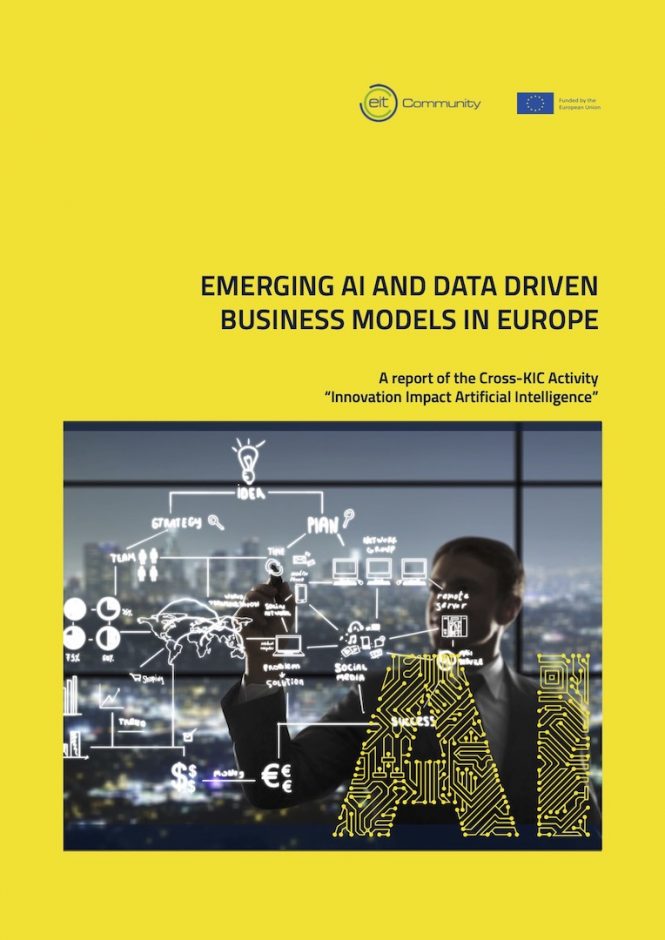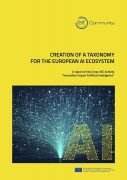Artificial intelligence business models and taxonomy in Europe

With its ability to drive productivity and economic development, artificial intelligence (AI) is already having a huge impact on our lives. But what are the AI business models in Europe? What AI landscape exists across Europe? What is AI’s impact in several sectors and on climate? And how do we talk about AI in the European AI Ecosystem?
With two new reports “Emerging AI and Data Driven Business Models in Europe” and “Creation of a Taxonomy for the European AI Ecosystem,” the EIT Artificial Intelligence Community provides answers.
The reports were conducted by the EIT Innovation Communities (KICs) EIT Climate-KIC, EIT Digital, EIT InnoEnergy, EIT Health, EIT Manufacturing, and EIT Urban Mobility in a Cross-KIC activity to foster collaboration in, education about and artificial intelligence’s uptake by European enterprises and society. The European Institute of Innovation and Technology (EIT), a body of the European Union, is well positioned with its vast network and broad thematic coverage to help Europe make the most of Artificial Intelligence’s potential and keep up with the AI technological race.
 The first-mentioned report “Emerging AI and Data Driven Business Models in Europe” is taking stock of the state of AI in the KICs’ innovation, education and business creation ecosystems. In summary, this report contains the results of surveys and a desk research study including:
The first-mentioned report “Emerging AI and Data Driven Business Models in Europe” is taking stock of the state of AI in the KICs’ innovation, education and business creation ecosystems. In summary, this report contains the results of surveys and a desk research study including:
- Mapping the AI landscape across Europe focusing on the area of national initiatives, regulatory frameworks and ethical guidelines
- Cross-KIC survey with EIT AI partners and findings
- Consolidation of various AI business models in Europe
- Consolidation of EIT AI partners’ perspective on AI benefit realisation
- Systematic mapping of AI applications across health, manufacturing, urban mobility and climate in Europe
Furthermore, this report gives recommendations on how to streamline knowledge, experience and expertise in AI deployment as well as connect, share and encourage an open innovation environment with policy leaders, industrial experts and innovator communities.
Download the “Emerging AI and Data Driven Business Models in Europe” report
 The “Creation of a Taxonomy for the European AI Ecosystem” report addresses the risk of losing oversight and efficiency in several AI activities, reports and the AI landscape. 35 existing frameworks have been scanned and analysed. The developed AI taxonomy is compatible with existing ones as long as they haven’t used incorrect or inconsistent clusters or categories.
The “Creation of a Taxonomy for the European AI Ecosystem” report addresses the risk of losing oversight and efficiency in several AI activities, reports and the AI landscape. 35 existing frameworks have been scanned and analysed. The developed AI taxonomy is compatible with existing ones as long as they haven’t used incorrect or inconsistent clusters or categories.
On top of that framework, a database structure has been built and integrated into the existing KIC tools. Moreover, an initial identification of the existing AI ecosystem in Europe has been conducted and added to the database. Finally, the European Commission and other European bodies’central documents have been analysed and compared to ensure compatibility. EIT ClimateKIC led the workpackage and collaborated with UnternehmerTUM to create this report.
Download the “Creation of a Taxonomy for the European AI Ecosystem” report
Emerging AI and data-driven business models in Europe
In 2020, the joint activities’ main focus was taking stock of the state of AI in the KICs’ innovation, education, and business creation ecosystems. As part of that, EIT Urban Mobility led this study by focusing on existing AI technology business models and applications across urban mobility, climate, manufacturing and healthcare sectors in the EU. The perspectives on the practices of AI technologies of over 60 individuals from EIT AI partners are captured. The survey included sections on the barriers and risks for AI adoption, methodological approaches to AI algorithm development and business models for AI deployment.
Generally, AI company business models can be categorised based on how much the business relies on AI:
- AI application provider – companies whose product simply could not function without AI at its core, whether they serve consumers or enterprises
- AI infrastructure provider – Companies providing AI tools and infrastructure (software and hardware to all companies)
- AI adopter – companies using AI as part of a broader product or technology stack
The revenue model can be roughly differentiated according to whether it’s based on AI application-as-a-service or AI infrastructure-as-a-service. Running a business based on an application-as-a-service (AaaS) basis is a licensing model, by developing applications for specific use-cases for their clients. The AI technology firms which provide AI infrastructure-as-a-service do this by offering computational services such as infrastructure and pre-trained algorithms. They charge the usage of AI technologies based on API calls.
In the report, you will find more information about the cost structure and the survey findings focusing AI technology development, AI technology deployment, AI impact on revenue generation and cost reduction, AI benefits across companies’ value chains, barriers and risks for AI adoption, political, legal and social ramifications as well as the value driver of AI solutions.
In the other chapters of the report, you will find a systematic mapping of AI applications across health, manufacturing, urban mobility and climate in Europe. For the climate sector, it looks like this:
AI’s impact on climate
AI applications in the climate sector are systematically mapped in Chapter 4 of the new report “Emerging AI and Data Driven Business Models in Europe”: What is AI’s impact on climate? It’s not only thinking about the risks of AI implementation, such as security risks from hackers. Or that training of an AI can be very computationally intensive, requiring a high amount of energy causing carbon dioxide emissions. Or using predictive AI to improve how oil and gas companies locate the most resource-rich drilling grounds.
Rather, AI has a critical role to play in reducing the carbon footprint of:
- Energy generation
- Transportation
- Food production
- Industrial manufacturing
- Our homes, offices and cities
For instance, in the power and electricity generation sector, utilities need better ways to predict how much energy is needed, in real-time and the long-term. AI algorithms can forecast energy demand, but they could be improved by taking into account finer local weather and climate patterns or household behaviour. Systematically mapped this would be an AI contribution for enabling low-carbon electricity in the subfield of variable sources by forecasting supply and demand. In the transportation sector a subfield of an AI contribution for electrical vehicles are charging patterns.
These and other AI contributions can be found on pages 25 to 30 of the report. Examples of AI applications are given as well: One of them is Cervest, which leverages AI to analyse billions of data points to forecast how changes in the climate will impact the futures of entire countries, down to individual landscapes, to allow businesses, governments, and land managers to adapt to climatic and extreme events.
Check out the Cross-KIC Activity Artificial Intelligence website


 Share this page
Share this page


